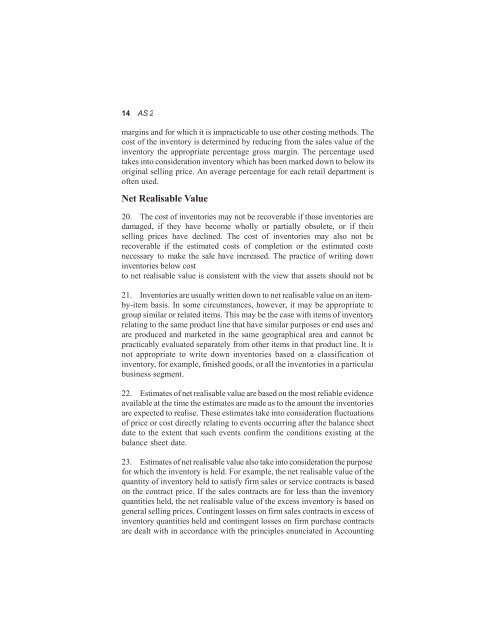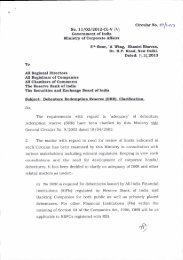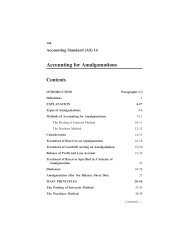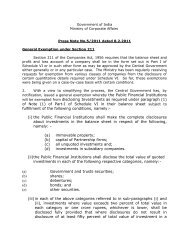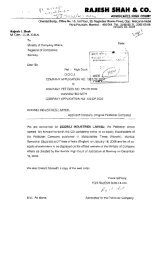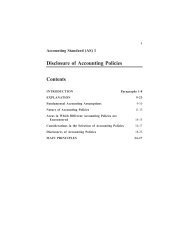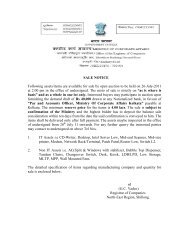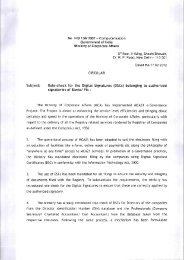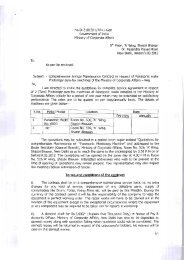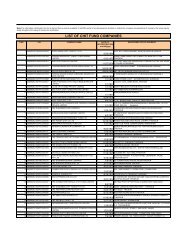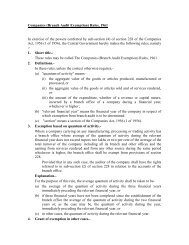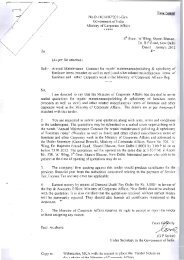Accounting Standard 2; Valuation of Inventories
Accounting Standard 2; Valuation of Inventories
Accounting Standard 2; Valuation of Inventories
You also want an ePaper? Increase the reach of your titles
YUMPU automatically turns print PDFs into web optimized ePapers that Google loves.
14 AS 2<br />
margins and for which it is impracticable to use other costing methods. The<br />
cost <strong>of</strong> the inventory is determined by reducing from the sales value <strong>of</strong> the<br />
inventory the appropriate percentage gross margin. The percentage used<br />
takes into consideration inventory which has been marked down to below its<br />
original selling price. An average percentage for each retail department is<br />
<strong>of</strong>ten used.<br />
Net Realisable Value<br />
20. The cost <strong>of</strong> inventories may not be recoverable if those inventories are<br />
damaged, if they have become wholly or partially obsolete, or if their<br />
selling prices have declined. The cost <strong>of</strong> inventories may also not be<br />
recoverable if the estimated costs <strong>of</strong> completion or the estimated costs<br />
necessary to make the sale have increased. The practice <strong>of</strong> writing down<br />
inventories below cost<br />
to net realisable value is consistent with the view that assets should not be<br />
21. <strong>Inventories</strong> are usually written down to net realisable value on an item-<br />
by-item basis. In some circumstances, however, it may be appropriate to<br />
group similar or related items. This may be the case with items <strong>of</strong> inventory<br />
relating to the same product line that have similar purposes or end uses and<br />
are produced and marketed in the same geographical area and cannot be<br />
practicably evaluated separately from other items in that product line. It is<br />
not appropriate to write down inventories based on a classification <strong>of</strong><br />
inventory, for example, finished goods, or all the inventories in a particular<br />
business segment.<br />
22. Estimates <strong>of</strong> net realisable value are based on the most reliable evidence<br />
available at the time the estimates are made as to the amount the inventories<br />
are expected to realise. These estimates take into consideration fluctuations<br />
<strong>of</strong> price or cost directly relating to events occurring after the balance sheet<br />
date to the extent that such events confirm the conditions existing at the<br />
balance sheet date.<br />
23. Estimates <strong>of</strong> net realisable value also take into consideration the purpose<br />
for which the inventory is held. For example, the net realisable value <strong>of</strong> the<br />
quantity <strong>of</strong> inventory held to satisfy firm sales or service contracts is based<br />
on the contract price. If the sales contracts are for less than the inventory<br />
quantities held, the net realisable value <strong>of</strong> the excess inventory is based on<br />
general selling prices. Contingent losses on firm sales contracts in excess <strong>of</strong><br />
inventory quantities held and contingent losses on firm purchase contracts<br />
are dealt with in accordance with the principles enunciated in <strong>Accounting</strong>


